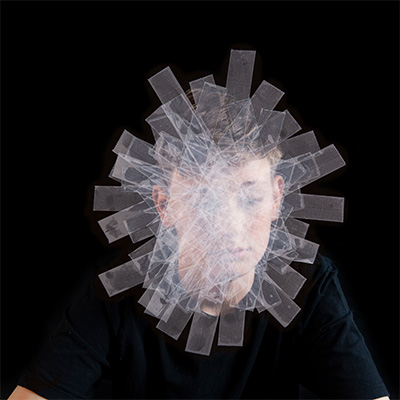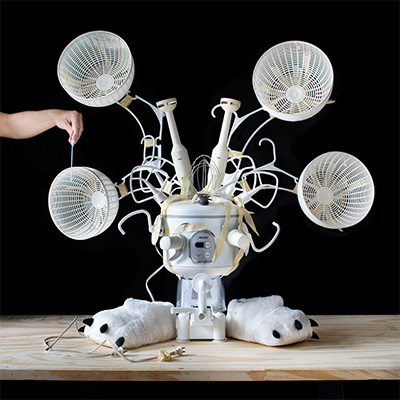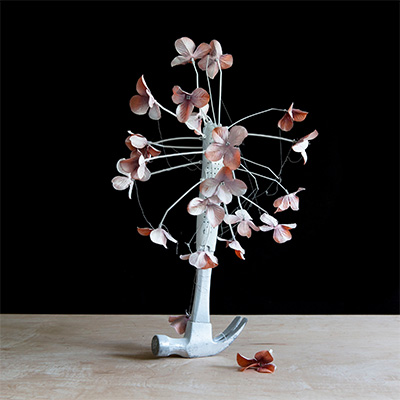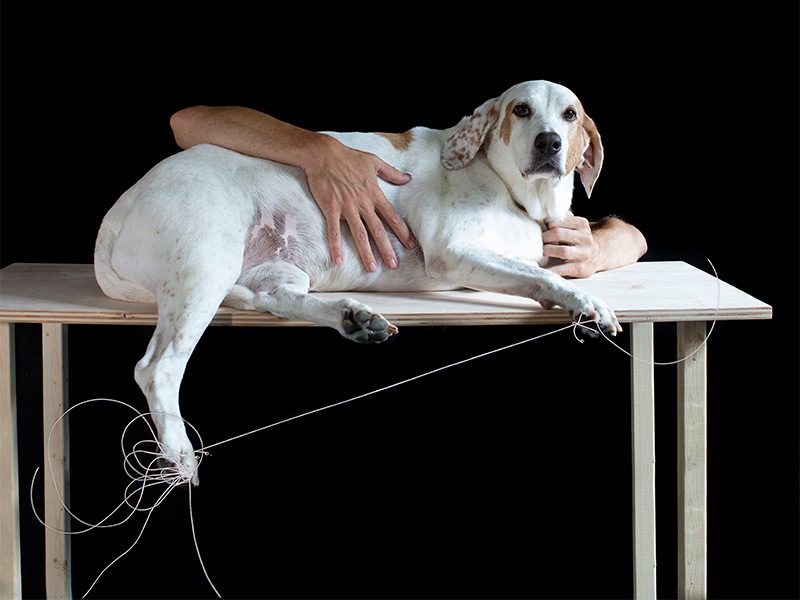Hillerbrand+Magsamen, A Device for Being Funny, not Frivolous, Archival Inkjet Print and Thread, 2019.
Do you know where your kids are? Maybe. Do you know where your cell phone is? Absolutely. For many of us, our devices control our lives. Hell, we can even program our phones to tell us where our kids are.
Deceptively simple questions like the ones above, along with the relentless navigation of life’s uncertainties, led Houston-based artists Stephan Hillerbrand and Mary Magsamen, known collectively as Hillerbrand+Magsamen, to address topics of family, communication, and consumerism, most recently through their ongoing body of artworks called The Devices Project. When toys break, kids grow up and leave home, hurricanes wreak havoc, shit hits the fan and life gets real, how do we deal with it? We turn to our devices to find the cure, ease the pain, and phone a friend.

Recently Hillerbrand+Magsamen have found especially poignant ways to highlight our desires to stay connected: 147 of them for starters. And this spring offers several opportunities to experience their work firsthand. This month, Heidi Vaughn Fine Arts in Houston presents Devices: Then and Now, an exhibition of photographs and sculptures, on view through March 29 as part of FotoFest Biennale 2020, with a book signing and artist talk on March 21. And as part of this year’s Fusebox Festival in Austin, attendees can visit Big Medium April 17 through 19 for 147 Devices for Integrated Principles, the performance aspect of The Devices Project. The dynamic piece includes live music with composer Peter Stopschinski and participation from Kirk Lynn of the theatre collective Rude Mechs, and takes place as part of a tandem 147 Devices for Integrated Principles exhibition which will be on view at Big Medium April 17 through May 15.
In 2018, Hillerbrand+Magsamen’s 147 Devices for Integrated Principles debuted as “a live lecture-performance” at The MATCH, during which the couple and their two children, Maddie and Emmett, showed audience members how to create and interact with fictional tools—“homemade” devices—created from everyday domestic objects (think spatulas, black trash bags, toys, laundry hampers, light bulbs). Examples include A Device for Swallowing the Apocalypse, A Device to Let Go of the Lump in Your Throat, A Device to Forget, A Device to Talk to God.

For the upcoming presentation at Big Medium, however, Hillerband+Magsamen explain that they have reworked almost half of the piece. When pressed for specifics, they refer to Bingo and a 1-800 call-in number, a helpline device of sorts. What they did reveal in detail is that the revised performance will essentially build the exhibition, unfolding it in the same space. It includes a mixture of almost clergical litanies and monologues, actions on stage and off, photographs, projections, tear sheets and, of course, devices. After the three performances, the exhibition walls will be covered, devices will be stacked and shelved, creating a curious, pseudo-laboratory in black, white, and silver—even a little bling—for the run of the exhibition. (Keep an eye out for a Little Tykes car; it will be hard to miss.)
The spirit of their work is rooted in their own special brand of interdisciplinary experimental art, what they call Suburban Fluxus. But The Devices Project is also about finding ways to connect with each other, especially in those moments when it seems a tinfoil hat just might provide the bit of protection we need to make it through. As Magasmen explains, “There are lots of moving parts but the core idea of the work is to connect with people.”

Hillerbrand+Magsamen attribute the longevity of The Devices Project to their collaboration with Stopschinski and Lynn, saying that when they would listen again to Stopschinski’s music or re-read Lynn’s writing, they would have four or five more months worth of ideas.
And they have become near-mad scientists in developing those ideas and making the ordinary extraordinary. In keeping with their what-do-we-have-too-much-of, experimental, consumer-critique approach, the artists found an old bin of their kids’ art supplies—10-year old play dough, popsicle sticks, yarn— and thought, “Can we use any of that?” Put simply, the answer was “yes,” but no experiment is worthwhile without a bit of trial and error.
“Some of the material we tried to use didn’t work…sometimes a popsicle stick is still a popsicle stick,” says Stephan, laughing.
But when they combine just the right objects, it’s like a magic prescription. Thin wooden craft sticks skewered into silver headphones make up A Device for Bribing Your Subconscious. Salad spinner plastic baskets, hand-held immersion blenders, rice cooker, and fuzzy polar bear slippers morph into A Device for Relating to Grandeur. A hat of melting vanilla ice cream slips into A Device to Restrain Contempt.

“It’s about transformation. We give these materials a new function or job to do. A one-use plastic straw that typically gets thrown away gets turned into a special, aestheticized object: a device that will heal your heart,” they say in agreement.
—NANCY ZASTUDIL

